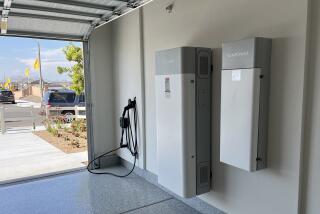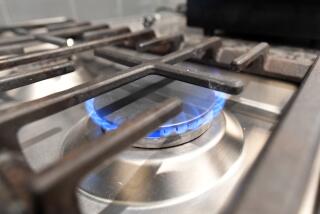The look is chic, the idea is hot, but ...
- Share via
A new generation of fireplaces fueled by natural gas or ethanol promises a cool modern look, not to mention a cleaner burn -- and just in time. Last week the South Coast Air Quality Management District board announced that a year from now, fireplaces in most homes built or remodeled in Southern California must be fueled by clean-burning alternatives to wood.
Modern designs hitting the market -- some mounted on a wall, no chimney required -- have received much hype. But are they good, or even legal? A rundown:
Wall-mounted gas
Lennox Hearth Products’ lineup includes the Radium, which is less than 8 inches deep and hangs on a wall like a plasma TV. This spring the company will introduce an Elite model that hangs on stainless steel pillars and looks as if it’s floating. Both require a natural gas line but no exhaust to the outdoors.
European Home offers similar wall-mounted models framed in brushed stainless steel and lined with crushed glass. They do vent to the outside.
Advantages: It’s a contemporary look. Natural gas results in fewer emissions than wood and no messy ashes. There’s no need to buy or store wood or hire a chimney sweep. Lennox says its vent-free models use catalytic-converter technology to clean the hot air as it leaves the combustion chamber. But . . .
Drawbacks: All unvented gas space heaters -- including the Lennox models -- are banned for indoor use in California because of fears about carbon monoxide poisoning. Vent-less fireplaces can be used in covered outdoor patios, however. (Models such as European Home’s West End Wall Fire do vent to the outside, so they must be hung on an exterior wall.) The cost of cutting a hole in the wall, running a gas line and other prep work can run about $3,000. And though natural gas burns cleaner, it’s not a renewable resource.
Prices: $1,999 for the Lennox Elite; $2,500 for the West End Wall Fire.
Standalone ethanol
One line receiving a lot of press comes from EcoSmart Fire, whose free-standing units run on ethanol (denatured alcohol). Another company, DESA, will introduce a model this summer that has traditional-looking logs.
Advantages: Pure novelty, for one. The firebox can be placed in the middle of a room. No construction, installation or assembly is required. An EcoSmart representative says that a single burner in a room larger than 200 square feet avoids the ban on ventless heat sources because its flame doesn’t send out sparks, soot, smoke or harmful exhaust. The fuel is considered more renewable than natural gas. The flames are prettier than those produced by alcohol-gel cans.
“People are starting to do exciting things to make the flames dance,” says John Crouch of the Hearth, Patio and Barbecue Assn.
Drawbacks: The open flame still puts out as much heat as a candelabrum, presenting a potential hazard, as with any fire. (It’s safe to touch the outside of the firebox.) As Crouch says, these types of fireplaces still can look a bit like a tin of Sterno on a buffet table. The cost for ethanol is about $1 an hour. Unlike gas or electric fireplaces, which can start with a touch of a remote control, these require filling the burners with fuel. Although there is no fuel smell, there’s no wood-burning scent either.
Prices: EcoSmart’s Designer Range starts around $4,900. DESA’s ethanol models will be less than $1,000.
--


